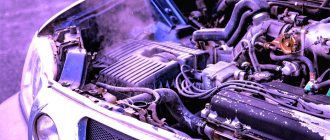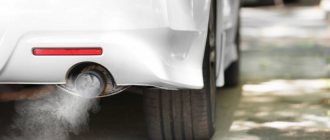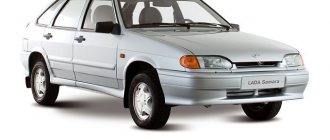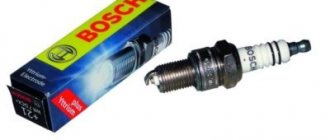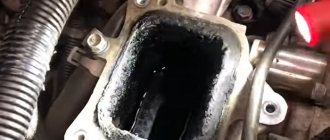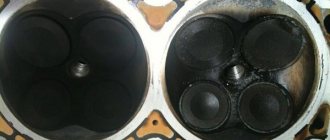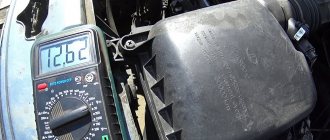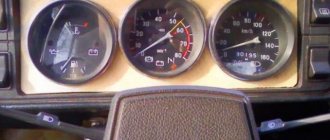Operating conditions and the attitude of the car owner towards his vehicle largely determine the service life and the manifestation of certain problems in the car.
We often hear about such a phenomenon as water hammer caused by water entering the power unit. In general, cars and water are not particularly friendly with each other, since moisture provokes the development of corrosion on the body, the appearance of rust, and the destruction of the paintwork. Plus, water can damage the wiring and cause a short circuit. And you shouldn’t forget about the notorious water hammer, since they actually destroy the engine, forcing the car owner to carry out expensive internal combustion engine repairs or completely change the engine.
Drivers need to be aware of the possible causes of water getting into the engine oil, as well as the necessary measures to take in such situations. Knowing the causes and triggers greatly helps prevent the negative effects of moisture. Or at least promptly and correctly eliminate the consequences of foreign liquid getting into the engine.
Routes of entry into the engine
The first step is to understand why water may suddenly end up in the oil, which is responsible for cooling and safe operation of the engine, which contains a large number of moving elements inside.
This phenomenon is indeed considered non-standard, since initially the design of the internal combustion engine is thought out and created in such a way that water and other external destructive factors do not affect the engine in any way. For this, various monolithic structures, seals, protection, etc. are used.
But in practice, it is almost impossible to completely protect a vehicle from water. Liquid can penetrate even the smallest holes, seep through cracks and reach the internal parts of the engine.
The primary source of water in the engine are considered to be puddles, ponds, and various water obstacles that you have to overcome in your own car. Moreover, water gets into the engine not only of those who engage in extreme overcoming of obstacles on the roads. This also often happens when operating a car in the city after heavy rainfall, broken pipes on the road, etc.
When the car is low-slung, that is, the ground clearance is low, and the puddle or pond through which it passes is deep, the fluid will most likely come into contact with the heated internal combustion engine. Do not forget that water is not compressible, that is, it does not have the property of compression, unlike gasoline or diesel fuel. Because of this, when water enters the combustion chamber, the piston experiences a strong shock due to the impact on the fluid. This leads to negative consequences in the form of destruction of engine elements.
Winter is also not the most favorable period, since drivers have to drive through snowdrifts and overcome snow and ice masses. If you add to them various reagents used to clear roads from ice and snow, you get a mixture that is extremely dangerous for metal. Gradually, the crankcase walls are destroyed. They rot and holes appear. Water quickly seeps through them and confidently moves towards the power plant.
The pan can accumulate moisture for more trivial reasons, when during careless driving it is hit, pierced, and gradually, during even light rain and after driving through small puddles, liquid collects there. But even a small amount of moisture in the crankcase is potentially dangerous for the internal combustion engine. That is why motorists are advised to regularly check the condition of the oil pan and eliminate any defects, punctures, cracks and holes that form. Simple prevention will allow you to avoid much more serious and dangerous consequences.
The worst thing about water getting into the engine is that the liquid mixes with the lubricant. As a result, the water-oil emulsion begins to move throughout the lubrication system, ending up directly on the engine cylinder head.
It is worth highlighting several main sources of moisture that ends up inside the engine:
- Oil may be mixed with water due to a crack in the oil pan itself;
- Or cracks have appeared in sections of the lubrication system line;
- In some cases, when the crankshaft on which the liner has rotated is performing poorly, strong impacts appear on the head. As a result, cracks appear between the water and oil lines in the head. Water penetrates through them;
- Condensation can be a potential source of trouble. Sometimes it forms directly inside the engine crankcase. This happens if you drive your car into a garage after a frost, where the temperature is quite high.
Regardless of the reasons, it is imperative to find the source of liquid penetration, carry out repairs if necessary, and also get rid of the extraneous moisture itself. Otherwise, you may face dangerous and costly breakdowns.
What is engine hydraulic shock and what is it used for?
Any car driver, be it a professional who has driven many hundreds of thousands of kilometers over the years, or a completely “green” student driver, should know the following: water (moisture) on the road in any physical state and quantity is fraught with great danger. Moreover, the same grip on the road surface in the presence of H2O (water) on it in any way and very noticeably reduces the required coefficient of grip on the road. For example, during heavy and heavy rainfalls, and especially due to improper operation of the storm drains themselves, large and even huge puddles may appear on the road, which are sometimes very deep and when driving through them, the car’s engine can simply “seize” (i.e. choke). ) of water, thereby receiving the so-called water hammer (water hammer). Today, dear friends, we would like to talk about exactly such an unpleasant and extremely harmful phenomenon for internal combustion engines, especially as water hammer.
First, let's look at the theory itself.
Possible consequences
The presence of water in the engine oil is always a bad sign. This is a dangerous phenomenon that must be combated as soon as the first signs appear.
The most undesirable and unfavorable consequence is considered to be water hammer in the engine. Such a phenomenon can literally lead to rupture of the power plant due to the destruction of internal combustion engine components. If a water hammer occurs, there is practically no chance of restoring the engine by repairing it.
A much more acceptable situation is when water found itself in the combustion chamber while the engine was running at low or idle speed, and the internal combustion engine did not have time to warm up to its maximum operating temperature. If the circumstances are this way, then the driver will encounter only minor deformation of the connecting rod. In this case, the remaining moisture can probably be removed using the release valve. The engine will remain in working order, and the car will be able to move on under its own power.
What are the dangers of moisture penetration?
The dangers caused by liquid entering an engine depend on the path through which it enters. Mixing moisture with motor oil turns it into an emulsion. The lubricant loses its original properties. If water gets into the oil, the internal combustion engine suffers damage:
- scoring on the surface of the cylinders;
- destruction of valve stem seals;
- wear of the crankshaft and bearings;
- occurrence of piston rings;
- the appearance of backlashes;
- formation of corrosion spots.
Corrosion in cylinders
Signs of water in the engine
In practice, it is very difficult to completely protect against possible water ingress into engine oil. This requires driving the car extremely carefully, avoiding even the smallest puddles, not leaving the garage during rain and snow, monitoring the temperature in the garage to avoid the formation of condensation, etc.
Everyone understands perfectly well that no one is immune from such a problem. Therefore, in such a situation, it is extremely necessary to be able to recognize signs of water entering the engine in order to promptly take appropriate measures to remove it from the engine oil system.
There are several useful recommendations on how you can independently determine the water in your car’s engine oil:
- Air filter. First, try unscrewing the air filter cover on your car. Even in situations where liquid has penetrated through the crankcase openings, it will be virtually impossible to stop further progress throughout the entire system. If the air filter is wet, water is dripping from it, or the humidity of its filter membranes is simply increased, there is a problem;
- Oil pan There is also a special lid that you can unscrew with your own hands. In normal condition, after dismantling, engine oil begins to flow out of the sump in a pure form and in good condition. If it flows into oil and water, then the car is obviously flooded with a large amount of liquid dangerous to the engine. Here, the first thing you need to do is try to completely drain the emulsion.
If after draining it seems to you that the system is completely cleaned and not a single drop of moisture remains inside, do not rush to start the engine. This is fraught with dangerous consequences.
In this situation, it is recommended to evaluate the current condition of the engine components. You should first find out whether the moisture has had time to cause trouble in the engine. The cylinder-piston group and crankshaft are checked.
If a water hammer occurs, even a superficial inspection of these elements makes it clear that everything is very bad. This is due to deformation and large-scale damage to the crankshaft and piston-cylinder group, which are impossible to miss visually.
If a visual inspection does not allow you to get an accurate answer, you can try setting the manual transmission to third gear, and then roll the car literally a few meters so that the crankshaft rotates. If the shaft rotates, then the problem of a stalled motor is probably not at all caused by trapped water. Especially when, when removing the cover from the pan, you did not find any traces of water in the leaking oil. Here you will have to look for another source of trouble.
What is water hammer?
Water hammer (water hammer) is a sharp increase in pressure in the cylinder or cylinders of the engine itself, which occurs as a result of the ingress of a certain amount of water or other liquid sufficient to cause damage. As a result of this very liquid entering the part of the combustion chamber of the internal combustion engine located above the piston, when the piston moves upward, it prevents the latter from completing the given and necessary cycle, and as a result, serious damage to the internal parts of the engine occurs.
While the air-fuel mixture is compressed and allows the piston to perform reciprocating movements inside the cylinder itself, the liquid, as we know from a school physics course, practically stops compressing. This very fact means that the piston’s attempt to compress the liquid will not be successful and it will thereby fail, that is, it will simply break and the connecting rod or the rod itself will bend under it, or the cylinder head pin may break off or the cylinder head gasket may rupture.
Algorithm of actions
Although water ingress is not a good sign, it does not always penetrate the oil of the engine lubrication and cooling system and cause problems with your engine.
It happens that when driving through another puddle or other water obstacle, the engine suddenly stalls. It is not necessary or even necessary to panic right away. It is possible that everything is fine, and you will soon be able to continue driving under your own power without any consequences for the integrity of the engine.
But if such a situation happens to you, first stop and turn on the handbrake. This will protect the car from accidentally rolling down a slope on the road surface. After this, the following actions are performed:
- Get out of the car, open the hood to let the resulting steam escape. After all, contact of a hot engine with water will certainly lead to abundant steam formation. You should not leave it inside, as condensation will form and moisture will settle on different surfaces;
- Using dry rags, paper towels and other available materials that can absorb water, go over all surfaces of the engine compartment. The first step is to remove moisture from the wiring so that not a drop of water remains. If you are afraid to touch them, first remove the negative terminal from the battery;
- Wipe thoroughly all existing recesses located near the spark plugs. Moisture is also removed from the ignition distributor cap and coil.
Cracks
Mechanical damage to the cylinder block or head most often occurs when the coolant freezes. Therefore, monitor the temperature characteristics of the antifreeze used in the system. Do not pour water into the radiator under any circumstances. It will remain even after draining; as a result, it can freeze in any most inconvenient place. Most often, the channels of the block or cylinder head rupture.
Cracks can also appear after an accident. Even a small collision with a curb in frosty weather can cause mechanical damage. Therefore, be extremely vigilant when traveling.
You can protect your engine only by careful driving, as well as by following the standards for choosing antifreeze. You also need to regularly check the fluid level in the cooling system, as well as the condition of the oil.
Is it worth changing the oil and antifreeze?
If both fluids have changed color and consistency, they must be replaced. This is the only way to completely remove water from the engine. But don’t rush to fill in good liquid right away. It is important to flush the system thoroughly. These can be specialized flushing fluids (the so-called “five-minute fluids”), or cheap oil and antifreeze. The latter option is more gentle and is suitable for cars with a complex internal combustion engine. After filling the liquid, turn on the engine for 15-20 minutes, keeping it at different speeds. Afterwards, the flushing oil and antifreeze can be drained. Moisture will be completely removed from the system.
Ways to avoid this situation
As a result, we can highlight several recommendations from experts that will help you avoid an unpleasant situation. Thus, it is recommended to change the oil after a mileage of 7-9 thousand kilometers, despite the fact that automakers set longer periods. After all, they are not responsible for the oil.
Another tip is to try to avoid short trips. Otherwise, as a kind of “balancing”, it is worth doing long runs of 100-200 kilometers from time to time. In addition, it is important not only to care for your swallow, but also to monitor it. An attentive car enthusiast will see changes in the initial stages of damage.
Video
Operating conditions and the attitude of the car owner towards his vehicle largely determine the service life and the manifestation of certain problems in the car.
We often hear about such a phenomenon as water hammer caused by water entering the power unit. In general, cars and water are not particularly friendly with each other, since moisture provokes the development of corrosion on the body, the appearance of rust, and the destruction of the paintwork. Plus, water can damage the wiring and cause a short circuit. And you shouldn’t forget about the notorious water hammer, since they actually destroy the engine, forcing the car owner to carry out expensive internal combustion engine repairs or completely change the engine.
Drivers need to be aware of the possible causes of water getting into the engine oil, as well as the necessary measures to take in such situations. Knowing the causes and triggers greatly helps prevent the negative effects of moisture. Or at least promptly and correctly eliminate the consequences of foreign liquid getting into the engine.
First start
The first actions upon contact with water, which provoked a sudden stop of the engine, are quite understandable and obvious. Here you need to try to remove all the water, wait for it to evaporate, and then try to start it.
Under no circumstances should you rush to turn the key in the ignition after a couple of wires with a rag in the engine compartment and try to move off. If possible, it is recommended to take the car towed or contact a towing service. Even when it seems to you that nothing terrible has happened, water has not leaked inside, it’s not worth the risk. Better to play it safe.
If there is no way to tow cars or call a tow truck, you will have to rely only on yourself. In this situation, as mentioned earlier, wipe the entire engine compartment and try to remove as much liquid as possible from the surfaces. Then you will need to let the car stand so that the water evaporates naturally.
In the case of older cars that do not have electronic control units, additionally, during drying, it is possible to remove the spark plugs, distributor cap and coil. But if you have a car with electronic filling that is controlled through an ECU, it is strictly not recommended to carry out such manipulations. Just let the water evaporate on its own, don’t write it off, be patient.
If the spark plugs have been removed, then you can start the starter without any risk to the integrity of your engine’s cylinders. Starting the starter will help ventilate the chamber in which the combustion of the air-fuel mixture occurs. But even here, the optimal solution would be to leave the car to dry for about a day, and only then carry out the first test run after extensive contact with water.
When leaving the car for a day, it is recommended to remove the negative terminal from the battery, close the car in a garage where there is a ventilation system, otherwise the moisture will not be removed from the room, but will begin to evaporate and settle in the form of condensation.
After waiting for the engine to dry naturally, return all previously removed components to their place, and try to start the engine with the spark plugs already installed. If turning the key in the ignition does not start the engine, do not try to get it to work by towing. This is an extra waste of your nerves and engine life. You will need to contact a service center, where it is better to deliver the car itself by tow truck.
Already at the car service center, specialists will be able to check the presence of water inside the engine, and will also detect breakdowns, cracks, holes and other passages through which water could penetrate there. These weak points will definitely need to be eliminated by replacing gaskets, seals and other measures. If cracks and breakdowns occur, then welding work may be required, or replacement of individual engine components.
When the injection system fails, there may be too much fuel in the combustion chamber. This also leads to a water hammer effect that can cause a rupture of the power unit housing of your vehicle.
To summarize, we can say with confidence that the presence of water in the engine does not bode well. This is an extremely dangerous situation; if you do it incorrectly, you can completely destroy the engine with your own hands and doom yourself to the need to completely replace the power plant.
But even if you are faced with a similar situation, water has entered the engine, and there is a possibility of it penetrating inside the motor, do not panic. First of all, be sure to turn off the engine. This is the most correct decision in the current situation. If you hesitate and ignore obvious signs of a problem, in the very near future you will experience the phenomenon of water hammer. Its consequences are terrible. And from a financial point of view, they are very expensive. You can say goodbye to an old engine after a water hammer. It is not difficult to imagine the approximate cost of a new motor.
The best prices and conditions for the purchase of new cars
Result
Based on the foregoing, you can emphasize several rules for yourself that will allow the motor to live much longer.
- The manufacturer is not responsible for the lubricating fluid that you fill in, so you should not listen to the manufacturer and change it every 7-8 thousand kilometers, despite the fact that the manufacturer promises a lower frequency.
- Short trips are dangerous, but unfortunately this is the rhythm of life for many. As a preventive measure, you can simply go to your relatives or friends in a city that is 100-200 kilometers away from you. You can just take a ride to another city.
- And finally, just keep an eye on the engine and the car in general. A good owner immediately notices any malfunctions and eliminates them, and the car reciprocates in the form of a long service life.
Causes
How can water get into the engine? This problem occurs due to various reasons. We list the most common of them:
- Deformation of the oil pan. If the car is old, the pan may rot under the influence of reagents. Mechanical damage that can occur on a country road should not be ruled out. In both cases, the tightness of the sump is broken - oil gradually leaves the engine, and dust and water enter the crankcase.
- Careless passage of water obstacles. Not only fords, but also puddles pose a great danger. The higher the speed, the more spray gets onto the ignition elements and into the intake manifold.
Overcoming a deep puddle
- Cylinder head gasket failure. This can happen due to high mileage, or when the surface of the head is deformed (due to overheating). Incorrect installation (the torques and tightening pattern must be observed) and poor quality of the gasket itself should not be ruled out.
- Crack in the cooling jacket. Occurs due to detonation, untimely replacement of antifreeze and overheating of the internal combustion engine.
- Violation of the tightness of the air pipes. These are cracks, abrasions, poor tightening of clamps.
- Malfunction of the crankshaft (rotation of the liners), which leads to impacts of the piston on the cylinder head. The problem arises due to low level or quality of oil, operation of the internal combustion engine under heavy load and the entry of metal particles into the lubricant.
- Low quality lubricants. In an attempt to save money, car owners purchase low-quality oils (often “on tap” from large containers), which not only do not meet the requirements, but also contain a certain percentage of moisture. This can happen due to improper storage of liquids. High-quality, expensive oil does not contain moisture particles.
